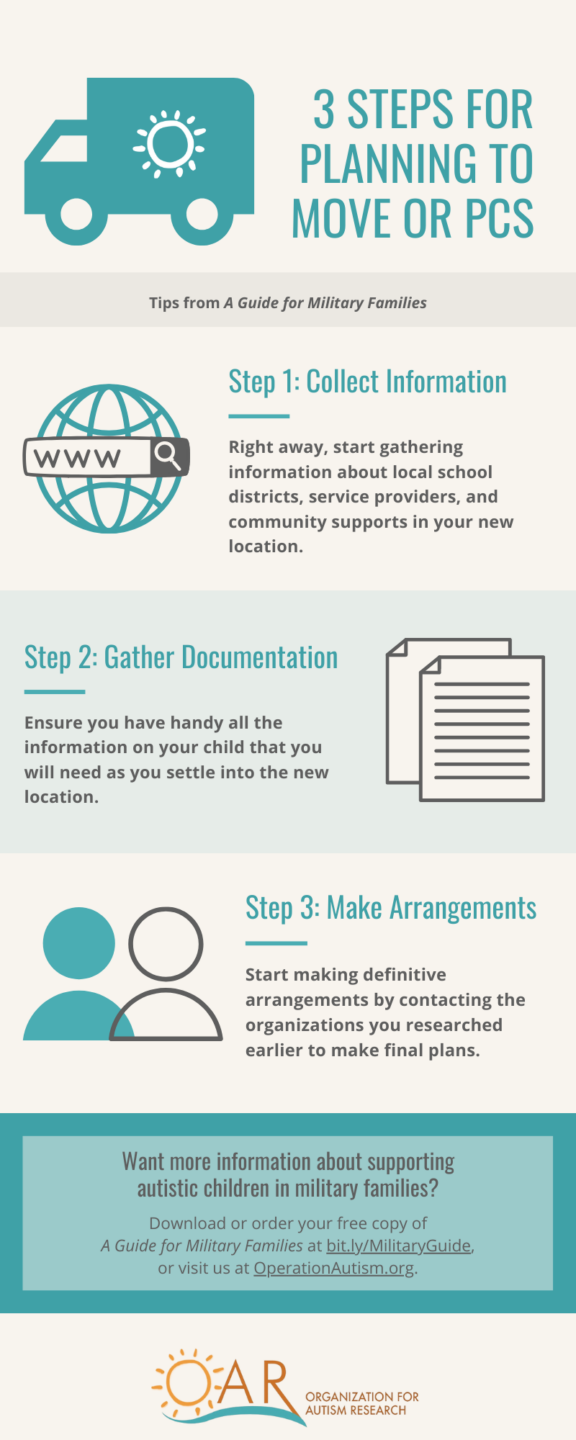While many civilian families move to new cities, states, or countries, moving is a fact of life for military families. Moving can be a difficult transition for anyone, but it’s especially challenging for autistic children, as it entails significant and sudden environmental changes. Whether you’re a military family PCSing or a civilian family moving for any other reason, this blog post and infographic will share some tips on how to prepare for the transition.
Step 1: Collect Information About the New Location
Begin collecting information on the new location as soon as you learn that a move might be on the horizon. Here are some suggested places/organizations to research:
- Local School Districts: Research local school districts and the autism services they provide.
- Review the websites of local school districts, looking specifically for information that might be relevant to your child.
- Follow up with a call to the school district’s special education office to learn more about the types of educational placements available, training and support available to teachers of autistic students, and the district’s approach to addressing behavioral issues.
- If possible, visit the potential school and ask critical questions.
- Tip: Do not assume that the services and supports established in your child’s Individualized Education Program (IEP) will naturally and smoothly follow, despite the provisions of the Individuals With Disabilities Education Act (IDEA). It is not uncommon for military families to have to seek command and legal support as they battle to protect and ensure the continuation of their child’s educational rights.
- Service Providers: If your child receives any services outside of school — such as ABA, Speech, OT, or other supports — make arrangements for continuity of care.
- In some cases, ABA may be covered by TRICARE. You can get a list of ABA providers from the regional contractors. Call the ABA providers and ask questions about the types of services that are available (clinic vs. homebased) and the credentialing of staff members.
- Enlist the regional contractor’s support for identifying available providers and resources.
- If your child is assigned a case manager, make sure to notify them as soon as you are aware you will be moving. The case manager can make contact at the new location and assist with a smooth transition.
- Community-Based Support Services: Contact state developmental disabilities councils and vocational rehabilitation agencies as needed to help obtain services for your child.
Step 2: Gather Documentation About Your Child
Ensure you have handy all the information on your child that you will need as you settle into the new location. On moving day, have a designated spot for the records and take them with you to prevent their misplacement or prepare for any unanticipated delays due to movers. Examples of records you might want to have on hand include a copy of a signed IEP, medical documentation of disability, and any information on allergies and/or other medical conditions. Be sure to include safety plans to address any medical conditions your child has.
Step 3: Get Ready for the Transition
Once you know that the request for orders is coming, start making definitive arrangements for the transition to the new location. This includes contacting the organizations you researched earlier to make final plans for your child’s arrival and arrange to start services. You will want to contact the following:
- All families:
- Local school district special education office
- Therapy providers
- Community-based service providers (e.g., vocational rehabilitation, intellectual/developmental disabilities agencies)
- Military families only:
- Exceptional Family Member Program (EFMP)
- School liaison officer
- Primary Care Manager
- Case Manager (if one is assigned)
One Last Tip: Take Advantage of Word of Mouth
Other parents and families can be excellent sources of information about resources and services. If you are not able to meet up in person, social media networks offer great ways to connect with other military families with autistic children.

For more information for military families of autistic children, visit Operation Autism.
